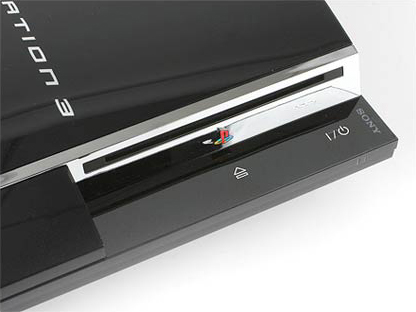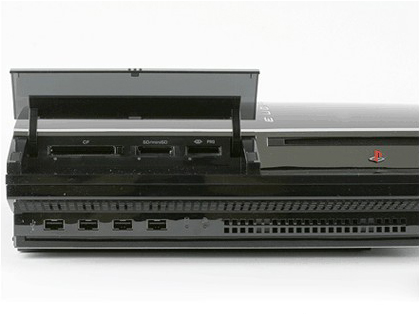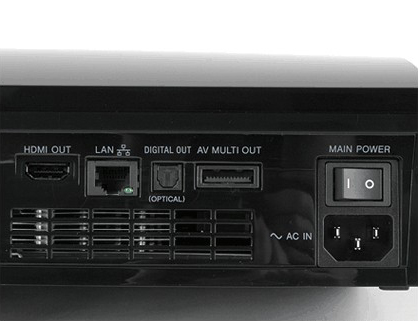Sony has been showing off prototypes of the PS3 for the last 18 months, and though the exact dimensions of the final unit were in doubt, the PS3's general shape and glossy finish have been set in stone for a while. Though it's been overshadowed in recent years by Apple's leading-edge MP3 players and computers, the PS3's sexy shape and futuristic look is ample evidence that the company's renowned design standards are alive and well. One look at its glossy exterior and touch-sensitive power and eject buttons on its face, and you can see why it might cost what it does.
Like the Xbox 360 and Nintendo Wii, the PS3 can stand vertically or lie horizontally in an A/V rack, though because of its curved top, it's not meant to have any other components resting on top of it. We saw early prototypes in white and silver colors, but at launch, the PS3 will be available only in black - the 20GB version is all black, the 60GB version is highlighted with a chrome trim - and there's no way to customize its look as you can with Xbox 360's interchangeable, if overpriced, faceplates. Judging from Sony's recent decision to bring out the PSP in more colors, we don't expect the company to stick to the black-only option for too long, especially since this system, like the PSP, is a fingerprint and smudge magnet. If you handle it at all, you'll end up having to wipe it off, so you'll probably just want to stick it in a rack and leave it there.
As for its dimensions, the PS3 measures 12.8 x 3.8 x 10.8 inches (WHL), which is roughly in line with the overall volume of the Xbox 360. That said, the PS3 does weigh a bit more - 11 pounds to the 360's 9.9 pounds including power supply - so if you're going by heft alone, you're getting almost 10 percent more console. Most impressively, there's no external power supply for the PS3; you just plug the included power cable - it's the same standard 3-prong style you'll find on most desktop PCs - into the back of the unit and you're good to go. For those of us who own an Xbox 360, and have had to struggle with its massive brick of a power supply, this seems like a remarkable feat on Sony's part.

Like the Nintendo Wii, the PS3 has a slot-loading disc drive.
One obvious difference between the Xbox 360 and the PS3 is the way you load media. As opposed to the more typical tray loader, the PS3 has a front-slot-loading, Blu-ray optical-disc drive, which contributes to the unit's slicker appearance. Discs slide in and eject smoothly enough, so chalk one up for the PS3 here (how the mechanism wears over time, we can't say - but the odds of snapping off or damaging the Xbox 360's disc tray aren't exactly negligible).

Media card readers are located beneath a flip-up door, and four USB ports are nearby.
On the front, you'll find four USB ports for connecting (and charging) controllers and other accessories, including USB keyboards, thumbdrives, and the PSP. The high-end $600 PS3 also offers a built-in memory card reader behind a door that supports not only memory cards from Sony's entire Memory Stick family, but Compact Flash and SD/MMC cards as well. (Sorry, Olympus fans - there's no built-in xD support, but you can still hook up your camera - or an external card reader - via USB.)

You'll find HDMI - but no USB - on the rear panel.
Around back is where you'll find ports for Ethernet, HDMI output, optical digital audio output (SPDIF), and the proprietary PlayStation A/V output for analog audio and video. A composite A/V cable ships with the unit, and because it uses the same connector as the PlayStation 2, that system's S-Video and component cables should work with it as well (to get HD video, you'll need component or HDMI). That's all fine, but we would have liked to have seen at least one USB port on the back for peripherals such as a camera (the EyeToy is compatible) that spoil the PS3's otherwise clean lines by sticking obtrusively out of the front. (Early prototypes seemed to have a USB port on the back, but it hasn't made it in the final unit, which is disappointing.) On a more positive note, the internal hard drive is said to be user replaceable (there's a slot on the side of the PS3 that allows you to swap in a new hard drive). However, like the Xbox 360, the PS3 utilizes the smaller 2.5-inch SATA drive that's made for laptops. Alas, those drives are twice - or even close to three times - as expensive as the larger 3.5-inch hard drive that goes into a desktop computer.
Sony PlayStation 3 Controller
Sony PlayStation 3's Interface
<< Back to Sony PlayStation 3 Review
Like the Xbox 360 and Nintendo Wii, the PS3 can stand vertically or lie horizontally in an A/V rack, though because of its curved top, it's not meant to have any other components resting on top of it. We saw early prototypes in white and silver colors, but at launch, the PS3 will be available only in black - the 20GB version is all black, the 60GB version is highlighted with a chrome trim - and there's no way to customize its look as you can with Xbox 360's interchangeable, if overpriced, faceplates. Judging from Sony's recent decision to bring out the PSP in more colors, we don't expect the company to stick to the black-only option for too long, especially since this system, like the PSP, is a fingerprint and smudge magnet. If you handle it at all, you'll end up having to wipe it off, so you'll probably just want to stick it in a rack and leave it there.
As for its dimensions, the PS3 measures 12.8 x 3.8 x 10.8 inches (WHL), which is roughly in line with the overall volume of the Xbox 360. That said, the PS3 does weigh a bit more - 11 pounds to the 360's 9.9 pounds including power supply - so if you're going by heft alone, you're getting almost 10 percent more console. Most impressively, there's no external power supply for the PS3; you just plug the included power cable - it's the same standard 3-prong style you'll find on most desktop PCs - into the back of the unit and you're good to go. For those of us who own an Xbox 360, and have had to struggle with its massive brick of a power supply, this seems like a remarkable feat on Sony's part.

Like the Nintendo Wii, the PS3 has a slot-loading disc drive.
One obvious difference between the Xbox 360 and the PS3 is the way you load media. As opposed to the more typical tray loader, the PS3 has a front-slot-loading, Blu-ray optical-disc drive, which contributes to the unit's slicker appearance. Discs slide in and eject smoothly enough, so chalk one up for the PS3 here (how the mechanism wears over time, we can't say - but the odds of snapping off or damaging the Xbox 360's disc tray aren't exactly negligible).

Media card readers are located beneath a flip-up door, and four USB ports are nearby.
On the front, you'll find four USB ports for connecting (and charging) controllers and other accessories, including USB keyboards, thumbdrives, and the PSP. The high-end $600 PS3 also offers a built-in memory card reader behind a door that supports not only memory cards from Sony's entire Memory Stick family, but Compact Flash and SD/MMC cards as well. (Sorry, Olympus fans - there's no built-in xD support, but you can still hook up your camera - or an external card reader - via USB.)

You'll find HDMI - but no USB - on the rear panel.
Around back is where you'll find ports for Ethernet, HDMI output, optical digital audio output (SPDIF), and the proprietary PlayStation A/V output for analog audio and video. A composite A/V cable ships with the unit, and because it uses the same connector as the PlayStation 2, that system's S-Video and component cables should work with it as well (to get HD video, you'll need component or HDMI). That's all fine, but we would have liked to have seen at least one USB port on the back for peripherals such as a camera (the EyeToy is compatible) that spoil the PS3's otherwise clean lines by sticking obtrusively out of the front. (Early prototypes seemed to have a USB port on the back, but it hasn't made it in the final unit, which is disappointing.) On a more positive note, the internal hard drive is said to be user replaceable (there's a slot on the side of the PS3 that allows you to swap in a new hard drive). However, like the Xbox 360, the PS3 utilizes the smaller 2.5-inch SATA drive that's made for laptops. Alas, those drives are twice - or even close to three times - as expensive as the larger 3.5-inch hard drive that goes into a desktop computer.
Sony PlayStation 3 Controller
Sony PlayStation 3's Interface
<< Back to Sony PlayStation 3 Review

 Add to Favorites
Add to Favorites
0 comments: